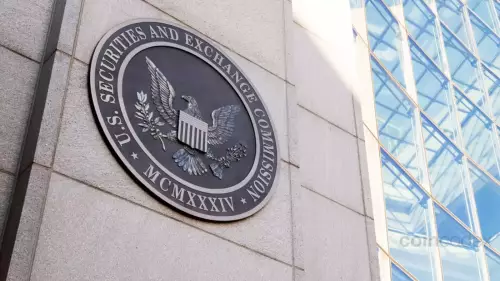 |
|
 |
|
 |
|
 |
|
 |
|
 |
|
 |
|
 |
|
 |
|
 |
|
 |
|
 |
|
 |
|
 |
|
 |
|
Cryptocurrency News Articles
Bitcoin, Quantum Threats, and Cyber Security: Navigating the Crypto Apocalypse
Sep 28, 2025 at 06:05 am
Quantum computing looms over Bitcoin, sparking a race for quantum-resistant cryptography. El Salvador leads the charge, while the industry braces for a seismic shift.

The buzz around Bitcoin, quantum threats, and cyber security is reaching a fever pitch. Is your crypto stash ready for the quantum apocalypse? Let's dive in.
The Quantum Horizon: Bitcoin's Biggest Threat?
As of September 2025, the fear of quantum computers cracking Bitcoin's code is more of a slow burn than a raging fire. Experts agree a full-scale quantum assault isn't happening tomorrow, but the rapid progress in quantum tech means we can't afford to chill.
Bitcoin's weakness? The Elliptic Curve Digital Signature Algorithm (ECDSA). While SHA-256 (used for mining) is tougher, the "harvest now, decrypt later" attack is a real worry. Imagine someone scooping up encrypted data today, just waiting for a quantum computer to unlock it down the road.
Quantum Reality Check: Are We There Yet?
Here’s the deal: today's quantum computers are impressive, but they're still toddlers. They have hundreds (maybe a little over a thousand) of qubits, but they're error-prone and don't last long. Cracking Bitcoin would take millions of error-corrected qubits – a far cry from where we are now. Some experts predict quantum computers could plausibly "rip" through Bitcoin's cryptography within less than five years.
But hey, companies like IBM are making moves. Their "Starling" project aims for a fault-tolerant quantum computer by 2029. That's like going from a tricycle to a rocket ship.
Industry's Quantum Response: Cautious Optimism and Post-Quantum Hustle
The crypto world is reacting with a mix of “meh” and “let’s get to work.” Some Bitcoin OGs aren't sweating it, but a growing number are diving into post-quantum cryptography (PQC) solutions. NIST (National Institute of Standards and Technology) finalized quantum-resistant algorithms in 2024, like CRYSTALS-Kyber for encryption. These are paving the way for quantum-secure digital transactions.
Beyond standards, blockchain-specific proposals are popping up. Think soft forks to integrate new signature schemes and radical hard fork proposals like Agustin Cruz's Quantum-Resistant Address Migration Protocol (QRAMP). New blockchains like The Quantum Resistant Ledger (QRL) and Quranium are being built from the ground up with quantum-native security.
El Salvador: Bitcoin's Quantum-Proof Fortress?
El Salvador is stepping up its game as a Bitcoin haven. They've moved their 6,284 BTC into 14 separate wallets, each holding less than 500 BTC. Why? To minimize the risk of quantum attacks by keeping those public keys hidden until needed.
Max Keiser even calls El Salvador "Bitcoin’s Statue of Liberty," urging investors to flee collapsing Western economies. Bold move, but it highlights the growing concerns over traditional financial systems.
Winners and Losers in the Quantum Shift
This quantum threat is creating a whole new landscape of winners and losers. Companies investing in PQC solutions are set to win big. We're talking about quantum-resistant software and PQC development firms like PQShield and Post-Quantum Ltd.
On the other hand, traditional Bitcoin mining companies could face a rough ride. If Bitcoin's cryptography gets cracked, their holdings could plummet. Exchanges like Coinbase and Binance are particularly vulnerable, as a quantum breach could wipe out user wallets. Proactive implementation of quantum-resistant solutions will be crucial.
The Big Picture: A Cybersecurity Paradigm Shift
This isn't just about Bitcoin. The quantum threat is a game-changer for all of cybersecurity and finance. Algorithms like RSA and ECC, the backbone of digital security, are at risk. This requires a complete overhaul and an urgent push for PQC. It's the most significant cryptographic transition in human history.
Navigating the Quantum Future: What's Next?
In the short term (5-10 years), watch out for "harvest now, decrypt later" attacks. Migrate your funds from older, vulnerable Bitcoin addresses. In the long term (beyond 10 years), the focus is on fully implementing PQC, replacing ECDSA with quantum-resistant alternatives. The consensus timeline for cryptographically relevant quantum computers (CRQC) is the 2030s or 2040s, so we have time, but not forever.
Bottom Line: Stay Vigilant, Stay Quantum-Ready
The quantum threat to Bitcoin is real, but it's not time to panic. It's a call to action. By embracing cryptographic agility and staying proactive, we can ensure the long-term viability of digital assets and the broader financial ecosystem. So, keep your eyes on NIST’s PQC updates, follow the Bitcoin community’s discussions, and maybe throw a few bucks at companies developing quantum-resistant tech. After all, a little paranoia keeps you prepared, right?
Disclaimer: This content is for informational purposes only and isn't financial advice.
Disclaimer:info@kdj.com
The information provided is not trading advice. kdj.com does not assume any responsibility for any investments made based on the information provided in this article. Cryptocurrencies are highly volatile and it is highly recommended that you invest with caution after thorough research!
If you believe that the content used on this website infringes your copyright, please contact us immediately (info@kdj.com) and we will delete it promptly.






























































